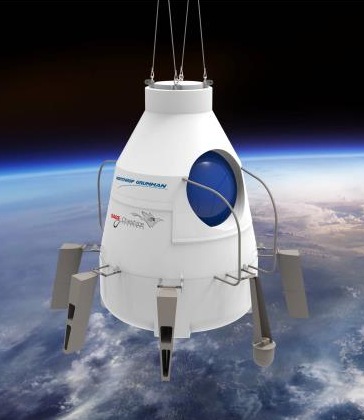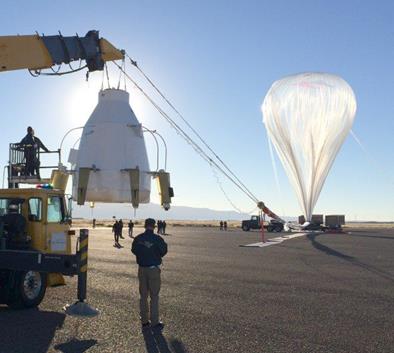Purpose of the flight and payload description
SPIRAL 1 was a proof-of-concept balloon mission to demonstrate that a communications payload, housed in a balloon gondola, can provide communications and Intelligence, Surveillance, and Reconnaissance (ISR) capabilities in the stratosphere. The mission was part of the developmental effort behind STRATACUS (Stratospheric C4ISR Unmanned Station) a Northrop Grumman strategic initiative aimed to provide a persistent, high-altitude platform to support warfighting scenarios. The STRATACUS platform operates at a nominal altitude range of 60,000 to 100,000 feet, which provides a field-of-regard of up to 770 miles in diameter.
The balloon gondola used for the mission, that we can see in the image at left, was provided by Sage Cheshire Aerospace. It was similar to the one built for the Red Bull Stratos mission that parachutist Felix Baumgartner used to break several high altitude records on his historical 2012 stratospheric jump. The main modification was the absence of life support systems allowing to dispose of a 6-foot-diameter pressure sphere inside the capsule that served to house scientific payloads.
The SPIRAL 1 payload, included a multi-enclave communications package combined with three High-Definition (HD) cameras as a notional ISR sensor suite. It was based on requirements from Joint Task Force Alaska (JTF-AK), which defined the capabilities they need for Arctic Edge 2014 (AE14); an Alaska-wide, multiagency exercise to be held in March and April of 2014. These requirements were based on the need for restored civilian and military communications in the event of natural or man-made disaster in Alaska. This would include access to multiple security domains stretching from unclassified to classified tactical networks (e.g., Secret Internet Protocol Router Network (SIPRNet). Therefore, the payload was built utilizing a ''black core" transport network supporting multiple, independent security enclaves.
Balloon operation including flight controls, the parachute subsystem, and all ground control subsystems was in charge of ATA Aerospace with the support of Air Force Research Labs, based out of Kirtland, AFB, New Mexico.
Details of the balloon flight
Balloon launched on: 11/2/2013 at 8:55 local
Launch site: Holloman Air Force Base, Alamogordo, New Mexico, US
Balloon launched by: ATA AEROSPACE
Balloon manufacturer/size/composition: Zero Pressure Balloon
End of flight (L for landing time, W for last contact, otherwise termination time): 11/2/2013
Balloon flight duration (F: time at float only, otherwise total flight time in d:days / h:hours or m:minutes - ): ~ 4 h
Landing site: WSW of Roswell, New Mexico, US
Payload weight: 3500 lbs
The flight took place at Holloman AFB on November 2, 2013. As the balloon was being inflated, the ground support team loaded dry ice for the capsule cooling system, verified the GoPro camera system, and confirmed the capsule door closure/sphere pressurization. While the sphere was being pressurized, the Northrop Grumman team discovered a ''NO GO" anomaly, and after depressurization found that a power cord was not fully connected/seated to the rack system. A foreign object damage check was completed, the rack mount flight safety pin was verified as installed, the pressure door was closed, and the capsule was repressurized for flight; wherein the capsule was then raised back to launch height, with all systems GO for flight.
After completing the balloon inflation, about 8:55 AM local time the balloon was released. A sudden shift in wind direction prior to launch precipitated an early release to avoid a ''pendulum swing" back towards the launch crane. During release the capsule incurred a 40-degree angle ''snap" swing. The kinetic actions caused the antenna arm assemblies to oscillate up and down. The forward directional Common Data Link (CDL) arm and aft ''camera arm" remained in the extended position with minimal swinging action noted. However, the right-forward omnidirectional (OMNI) CDL arm flipped up to the stowed/retracted position during the launch where it remained for the rest of the flight. The oscillation event for the remaining six antenna arms dampened out, leaving them in the extended position for the remainder of the flight.
The average vertical velocity indicator from launch to float altitude was 841 feet per minute which was completed in 75 minutes. Float altitude was 67,200 feet. All balloon systems were normal during the climb to float phase of flight. Auto track, impact-arming circuits, chute reefing-cutter arming circuits, and latched systems performed as designed. The highest wind noted during this phase as reported by weather was 64 mph at an altitude of 31,000 feet AMSL; middle of the jet stream winds was 44 mph at 48,000 feet AMSL.
At 60,000 feet AMSL at 10:00 local time, Sage Cheshire reported a drop in internal sphere pressure to ambient outside pressure. This data parameter indicated a total loss of capsule pressure in flight. At and/or around the same timeframe, Northrop Grumman reported ''loss of CDL C2 link" and loss of live-streaming video feed to Mission Control. After the loss of internal pressure and the C2 data link, ATA Aerospace confirmed they had positive control of the flight train with one issue noted to their Balloon and Experiment Control System (BECS) and/or High Altitude Balloon Tracking System (HABTS) (back-up balloon control) indicating no video feed from the BECS system GoPro camera. At 10:05, a mutual discussion in Mission Control led to a GO decision to continue the flight.
Prior to the CDL link loss, the Northrop Grumman STRATACUS payload provided live-streaming video feed (ISR capability) to Mission Control and the Spectrum Center facility in San Diego, California, which indicated full functionality of the blue and black networks-a major objective. ATA Aerospace systems were normal during the Float-on-Station phase of the mission with no issues noted. During the flight, several balloon vent/ballast operations were performed. This proved the rudimentary station-keeping capabilities of the stratospheric capsule and flight train system.
Northrop Grumman conducted STRATACUS payload checkout with the remaining operational systems. Voice bridging capabilities proved to be successful. Several attempts to regain C2 of the CDL link system were unsuccessful and two payload power cycles where performed in hopes of restoring the C2 links; this also proved to be unsuccessful. Once all available STRATACUS systems completed testing, the capsule and flight train were commanded to a desirable recovery area southeast of Roswell, NM for flight termination and recovery. This was done via a series of ballast and venting commands from ATA-Aerospace BECS system.
The STRATACUS capsule and payload landed via parachute at coordinates 33.2708 N - 104.8003 W in a point located west-southwest of Roswell, NM. The balloon landed 6 miles away from the capsule. The recovery crew found that the capsule landed on the antenna arms and part of the pressure door was missing from the capsule. Later analysis of the door failure was found to be caused by the kinetic actions and the payload tearing away from the floor during the 40-degree angle ''snap" swing during launch, wherein the payload racks impacted the door and led to the failure.
External references
- Description of the capsule Sage Cheshire website
- Stratospheric C4ISR Unmanned Station (STRATACUS) AIAA Balloon Systems Conference, 2017
12736If you consider this website interesting or useful, you can help me to keep it up and running with a small donation to cover the operational costs. Just the equivalent of the price of a cup of coffee helps a lot.



